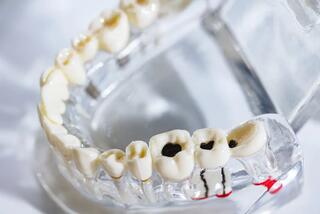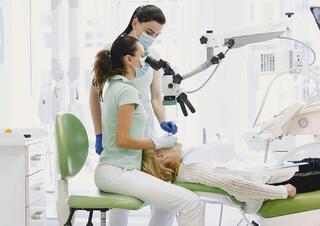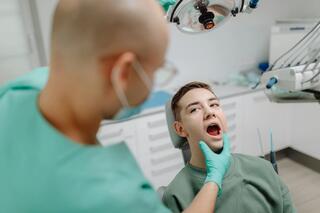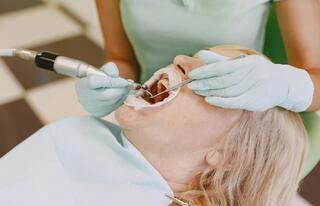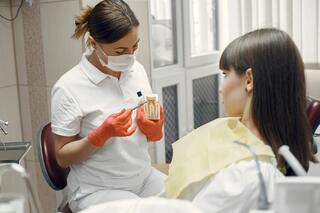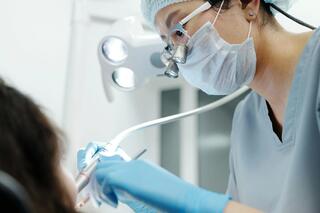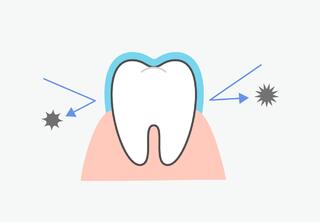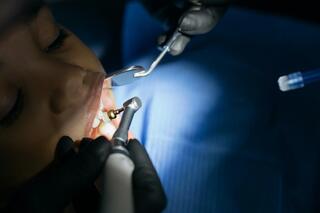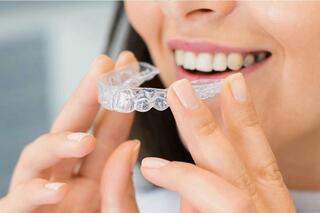Welcome to Dental Portal! Today, we're addressing a crucial topic: dental plaque. This bacterial film can cause a multitude of dental issues. The main causes include poor hygiene, smoking, and soft diets. There are various types of plaque, ranging from white to green. Removal methods include polishing, Air Flow, and ultrasonic treatments. At home, special toothpastes can be used. Neglecting to remove plaque is dangerous: it can lead to cavities and other problems. Learn more about how you can protect your smile!
Dental Plaque – What Is It?

After chewing food, microscopic food particles adhere to the micro-roughness on the tooth surface. Along with pathogenic microorganisms in the oral cavity, they form a bacterial film. If not removed within 1-2 hours (which is why dentists recommend brushing your teeth and rinsing your mouth after every main meal or snack), it becomes saturated with the mineral components of saliva and hardens. As it hardens, the bacterial plaque initially turns yellow, then darkens. Eventually, it becomes tartar.
Causes of Dental Plaque
- Consuming exclusively soft foods (which do not aid in the natural cleaning of plaque);
- Neglecting oral hygiene;
- Taking certain antibiotics and other medications;
- Smoking;
- Drinking water with a high iron content.
Types of Dental Plaque
By degree of mineralization:
- Non-mineralized. Just 5-10 minutes after brushing, a pellicle – a thin bacterial film – forms. It begins to interact with the mineral components of saliva, penetrating its porous structure. Proteins in saliva "assist" pathogenic microorganisms in firmly attaching to the tooth surface. This results in a soft microbial plaque.
- Mineralized. The primary mineralization of the soft plaque occurs within 6-10 hours, depending on the composition of the saliva. If not removed with a toothbrush during this time, it hardens. The process of tartar formation begins.
By color:
- White. Forms throughout the day or during sleep. It is easily removed, but if teeth brushing is neglected, it begins to harden.
- Yellow. The initial stage of soft plaque discoloration. Causes: poor oral hygiene, excessive consumption of sugary products, smoking cigarettes or hookah.
- Brown. Occurs in long-term smokers. Nicotine resins accumulated on the enamel form a dense brown film. Daily consumption of tea, coffee, and other staining drinks can also cause brown plaque.
- Black. Can form against the background of chemotherapy, taking antibiotics, hormonal imbalances, intoxication.
- Green. Appears in children due to the active proliferation of fungi in the oral cavity.
By location:
- Supragingival. Forms on the inner surface of the lower teeth and on the outer surface of the molars.
- Subgingival. Forms in the periodontal pockets. It is dark in color and hard.
Type of Dental Plaque according to ICD:
- K03.60 - pigmented (black, green, orange)
- K03.61 - caused by tobacco use
- K03.62 - caused by chewing betel
- K03.63 - other extensive soft (white) deposits
- K03.64 - supragingival tartar
- K03.65 - subgingival tartar
- K03.66 - dental plaque
- K03.68 - other specified deposits on teeth
- K03.69 - unspecified deposits on teeth
How to Remove Dental Plaque - Treatment Methods
Depending on the clinical picture, one of the following methods (or a combination thereof) is used:
Polishing with Abrasive Paste

This procedure allows for painless removal of bacterial and pigmented plaque, smoothing the enamel surface, and restoring natural shine.
How does it work?
The dentist attaches a special tip to the drill and first applies a paste with coarse abrasive particles (to remove dense plaque) and then a fine-dispersed paste. Over 10-20 minutes, the dentist treats the inner and outer surfaces of the teeth – first the flat surfaces, then the chewing surfaces. The interdental spaces are also treated.
Air Flow

If polishing with paste is insufficient to achieve the desired result, the Air Flow method is used.
The procedure (lasting 5 to 20 minutes) removes only pigmented and bacterial plaque as well as soft dental deposits.
How does it work?
The device creates a mixture of directed air flow, fine-dispersed sodium bicarbonate particles, and water. The dentist sprays the mixture onto the tooth surface. The abrasive particles break up the plaque, and the water washes away the destroyed deposits from the tooth surface. Along with pathogenic microorganisms in the oral cavity, they form a bacterial film. If not removed within 1-2 hours (which is why dentists recommend brushing your teeth and rinsing your mouth after every main meal or snack), it becomes saturated with the mineral components of saliva and hardens. As it hardens, the bacterial plaque initially turns yellow, then darkens. Eventually, it becomes tartar.
Pros:
- gently removes deposits even in hard-to-reach places (interdental spaces, gingival pockets);
- gently removes plaque from smoking, staining foods, coffee, tea;
- allows for cleaning braces;
- prepares teeth for whitening.
Cons:
- does not remove hard tartar;
- has a list of contraindications (gum inflammation, bronchial asthma, etc.).
Ultrasonic Cleaning

In one session (lasting 5 to 20 minutes), plaque with tartar can be removed, and the enamel can be lightened.
How does it work?
The dentist uses a scaler. It’s tip is moved by ultrasound and gently breaks down dental deposits. A fluid with antiseptic is sprayed onto the tooth surface under pressure. The fluid, along with the particles of destroyed deposits, is suctioned out of the mouth.
After the procedure, the dentist polishes the enamel to remove micro-roughness. Then, fluoridation is performed to enrich the enamel with minerals.
Pros:
- effectively removes soft and hard plaque;
- does not damage or thin the enamel;
- has an antiseptic effect (prevents gingivitis).
Cons:
- increased enamel sensitivity may occur within 2-4 days after the procedure.
Dentists recommend Air Flow for those whose teeth are relatively clean and only need to remove pigmented plaque.
For removing plaque from smoking, as well as extensive hard supra- and subgingival deposits, a combination of both methods is necessary. Ultrasonic cleaning is applied first, followed by Air Flow.
Dental Plaque – Before and After

Man tooth Before and After professional Treatment of Dental Plaque.
Can You Remove Dental Plaque at Home?
Light pigmented plaque can be removed with an electric toothbrush and toothpaste such as Lacalut White (with an RDA of 120) or President Profi Plus (RDA 200). Apply a small amount of paste to the front teeth. Use the electric brush on a low setting, brushing each tooth for at least 20 seconds. Rinse your mouth after brushing.
Choose toothpaste containing pyrophosphates, polydon, or sodium citrate. These ingredients prevent food pigments from sticking to the enamel. Also, pay attention to the toothpaste's abrasiveness – between 70 and 100 RDA.
It's impossible to remove tartar at home on your own. Avoid using homemade teeth whitening remedies, such as radish juice with lemon. Acid might slightly soften the tartar, but the negative effect is worse – calcium is leached from the enamel, increasing sensitivity to temperature.
What Happens If You Don't Brush Your Teeth?
Caries
Mineralized plaque on teeth contains many pathogenic microorganisms (Str. Mutans, Lactobacillus) that cause caries and periodontitis. They produce acids that demineralize the enamel, increasing the risk of caries.
Gingivitis
Tartar presses on the gums, causing irritation. The gums become red, bleed, and swell. Gingival grooves enlarge, forming periodontal pockets.
Periodontitis
The inflammation spreads to the deeper layers of the periodontium and bone tissue, which begins to atrophy. Teeth become loose and can fall out.
Stomatitis
Bacteria infect small wounds in the mouth, causing ulcers. With a weakened immune system, the risk of intoxication is high.
Infective Endocarditis
Bacteria from the gingival pockets can enter the bloodstream, reach the aortic valve, and cause inflammation of the inner heart lining.
What About Dental Plaques with Children?
Parents often consult dentists about dark spots on their child's milk teeth, especially near the gum line. This is known as Pristley's plaque. It results from the activity of certain bacteria in the mouth, which are naturally present in all children. These bacteria produce a dark pigment. It's not harmful to the teeth, but dentists recommend removing it because it:
- hides caries (difficult to detect among the dark spots);
- spoils the appearance of the smile;
- causes halitosis (unpleasant mouth odor).
Removing dark plaque from a child's teeth at home is not possible. It can only be removed in a dental clinic using the Air Flow method.
Dental Care
Advice from dentists:
- Brush your teeth with a toothbrush and toothpaste 2-3 times a day, especially after meals;
- Rinse your mouth every time after snacking;
- Daily remove food particles from between your teeth using dental floss (preferably before bedtime) or a water flosser;
- Visit your dentist every six months for professional cleaning to prevent the accumulation of plaque and tartar in hard-to-reach areas.
Frequently Asked Questions
What is dental plaque?
Dental plaque is a soft bacterial film on the teeth, formed from food residues and microorganisms.
Why does plaque form on teeth?
Plaque forms due to poor oral hygiene, smoking, consuming soft foods, and certain medications.
What types of plaque are there?
Types of plaque include non-mineralized and mineralized, and they vary in color: white, yellow, brown, black, green.
How can plaque be removed from teeth?
Plaque can be removed by polishing, using the Air Flow method, ultrasonic cleaning, or with special toothpastes at home.
Can plaque be removed at home?
Yes, if it is pigmented and not too severe. An electric toothbrush and toothpastes with controlled abrasiveness can be used.
What happens if plaque is not removed?
Unremoved plaque can lead to cavities, gum diseases, and the formation of tartar.
